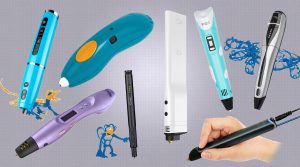The so called “cool ink” pens ( “cool” because it’s not hot , like the tips of the molten plastic FDR pens), work by squeezing out a resin that solidifies when the tip of the pen shines UV-light on it. Sounds cool and new science, now like the old plastic melters, right?
Wrong! The chemical process behind this isnewer than the idea of melting plastic… but it dates from the 70’s. I’t actually the technology behind another class of 3D printers, the SLA (or SL, from “stereolithography”) 3D printers that are fast and awesome, but less popular because they are more expensive than the FDM/FFF 3D printers of the current “consumer printing” revolution.
So the story is kind of like this:
- molten plastic filament 3D pens = kind of “handheld” and “manually operated” versions of a FDM/FFF 3D printers
- “cool ink” photopolymer 3D pens = kind of “handheld” and “manually operated” versions of a SLA 3D printer
Cool, but… how do they actually work? You mean the chemistry of it?
Hmm, this is complicated, but it kind of boils down to this:
(drawing from Wikipedia)
Instead of melting a ready-made plastic polymer, you have a resin made up of the components of the polymer, in a gel form, which come together and form the polymer when you shine light (UV-light most of the time) on it.
Now, the magic is in the thing call photoinitiator (the green stars above), the stuff that reacts to light and triggers the polymerization. We’re not experts on this, but we figure that this may be closely guarded trade secret behind the “cool ink” mixture.
From this, we can figure out quite easily what are the things that can influence the “performance” of a photopolymer pen:
- the quality of the photoinitiator compound from the ink – so use the manufacturer’s ink (there are no other options available for now anyhow) and hope their chemists did a good job
- the intensity and wavelength of the UV-light – if it’s too weak (or the wrong wavelength for a specific photoinitiator) it will fail to harden and result in a sticky gooey mess
- the battery capacity – of course you want it to last as long as possible to maximize the time of wireless fun, and quick charging would also be a plus here
The current generation of photopolymer 3D pens has room for improvement in all these areas. But they are pretty good, and they can do things that plastics pens can’t, like draw vertically in the air or at right angles and have the model stay up or draw without hardening at all, and only afterwards shine light on the goo to harden it (we’re not sure of the usefulness of this though…).
There are only a couple of “cool ink” UV-hardened photopolymer 3D so far. But they have clear advantages over the molten plastic pens and it’s worth checking them out:




